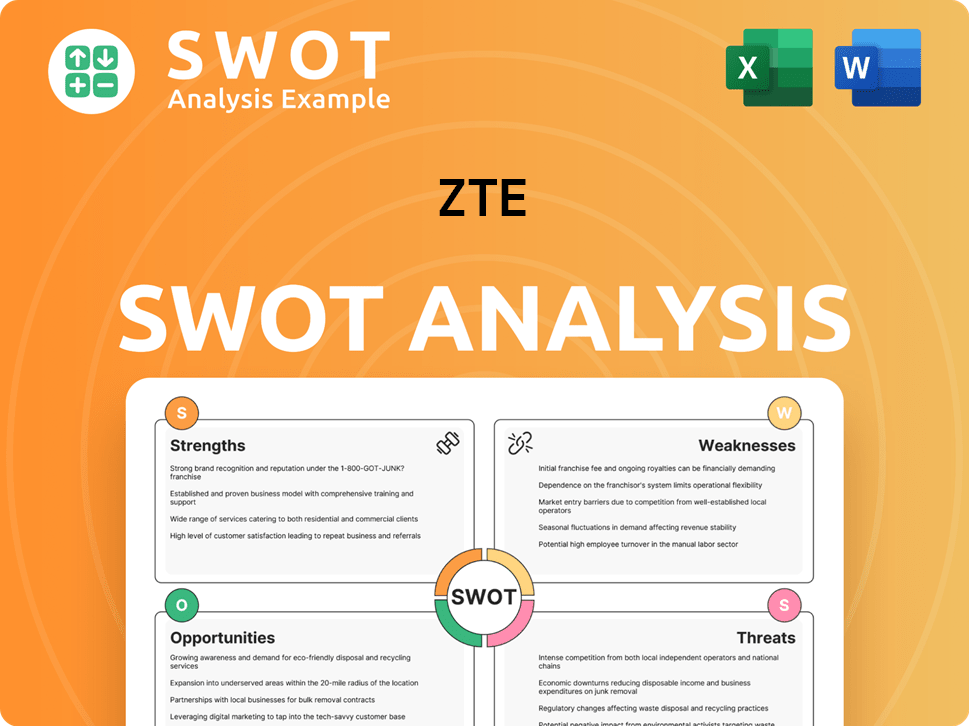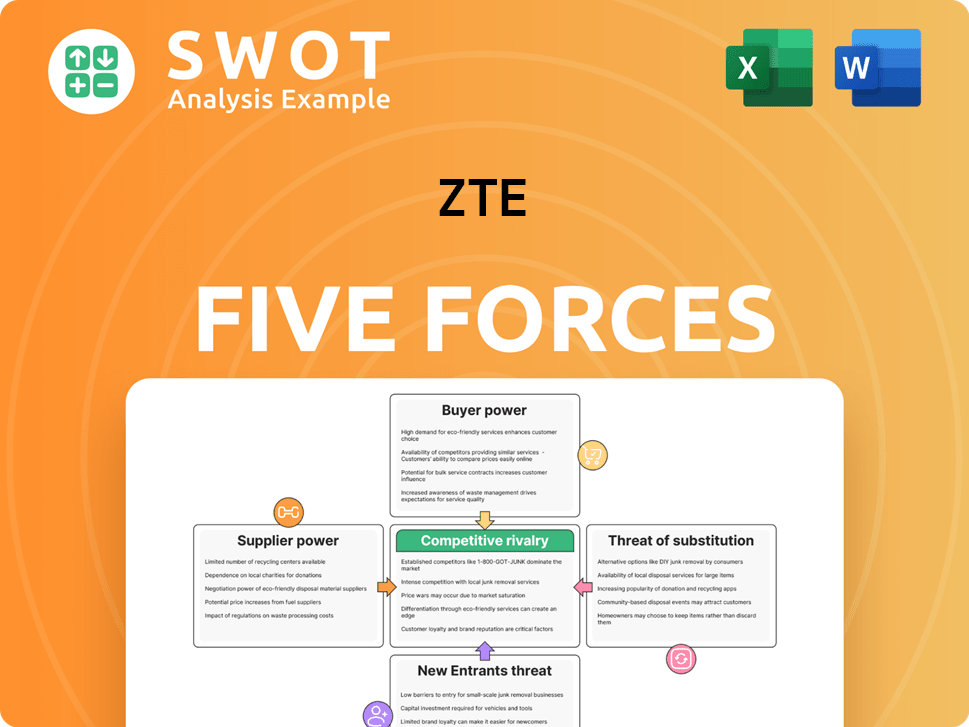ZTE Bundle
How did ZTE, a Chinese tech company, become a global force?
ZTE Corporation, a name synonymous with innovation in the telecommunications sector, has a fascinating history that spans decades. From its origins within China to its current status as a global player, ZTE's journey is a testament to strategic foresight and technological prowess. Explore the ZTE SWOT Analysis to understand its strengths.

This brief history of ZTE explores the company's evolution, from its early focus on domestic communication solutions to its expansion into a comprehensive portfolio of wireless, wireline, and device offerings. Understanding the ZTE timeline reveals the key milestones and strategic decisions that have shaped its trajectory. Examining ZTE's company background provides valuable insights into its global impact and future prospects within the ever-evolving telecommunications landscape.
What is the ZTE Founding Story?
The story of the ZTE company began on December 28, 1985. It started as Zhongxing Semiconductor Co., Ltd., in Shenzhen, China. The initial goal was to create telecommunications equipment to support China's growing economy.
The company was founded by investors connected to China's Ministry of Aerospace Industry. They saw a chance to provide technology solutions to state-owned businesses. The founders aimed to close the technology gap in China's telecommunications market.
Early funding came from state-backed entities and the founders themselves. This funding helped ZTE start its journey in the telecom industry. The company's early focus was on meeting the rising demand for communication infrastructure in China.
Here's a quick look at ZTE's early days and its impact.
- Founded in 1985 as Zhongxing Semiconductor Co., Ltd.
- Initial focus on telecommunications equipment for China.
- Backed by the Ministry of Aerospace Industry and state-owned entities.
- Aimed to bridge the technology gap in the Chinese market.
ZTE SWOT Analysis
- Complete SWOT Breakdown
- Fully Customizable
- Editable in Excel & Word
- Professional Formatting
- Investor-Ready Format

What Drove the Early Growth of ZTE?
The early growth of the ZTE company, a prominent Chinese tech company, was focused on the domestic market. This period saw the introduction of digital switching systems, which significantly boosted its presence in China's telecommunications infrastructure. ZTE's early years were marked by strategic investments in research and development, leading to the development of its own intellectual property.
In the initial phase, ZTE concentrated on the Chinese market, gradually broadening its product range beyond basic telecommunications equipment. Key developments included the introduction of digital switching systems in the early 1990s. This expansion within China was crucial for establishing a strong foundation. ZTE's focus on digital switching systems significantly enhanced its footprint in China's telecommunications infrastructure.
ZTE began its international expansion in the late 1990s, securing its first international contracts in countries like Pakistan. This marked a significant shift towards a global presence. These early international ventures were critical in establishing ZTE's brand and expertise in the global market. The late 1990s saw the company take its first steps into the international arena.
A key aspect of ZTE's early growth was its significant investment in research and development. This led to the development of its own intellectual property in mobile communication technologies. These investments were crucial for ZTE to compete effectively in the rapidly evolving telecom sector. The company aimed to build its own technological capabilities.
ZTE's early growth was also characterized by its listing on the Shenzhen Stock Exchange in 1997 and the Hong Kong Stock Exchange in 2004. These listings provided substantial capital for further expansion. By the early 2000s, ZTE had established a foothold in various international markets. The company leveraged its competitive pricing and robust product offerings.
ZTE PESTLE Analysis
- Covers All 6 PESTLE Categories
- No Research Needed – Save Hours of Work
- Built by Experts, Trusted by Consultants
- Instant Download, Ready to Use
- 100% Editable, Fully Customizable

What are the key Milestones in ZTE history?
The ZTE company has marked significant milestones throughout its history, evolving from its inception to a global player in the telecommunications industry. This Chinese tech company has consistently expanded its reach, contributing substantially to technological advancements and global network infrastructure.
| Year | Milestone |
|---|---|
| Early 2000s | ZTE entered the 3G market, becoming a key patent holder. |
| 2018 | Launched its first 5G end-to-end solution and began global 5G deployments. |
| 2024 | Continues to be a major player in 5G, with over 60 commercial 5G contracts globally. |
ZTE's innovations have been pivotal in shaping the telecommunications landscape. The company has focused on developing advanced network solutions and expanding its product portfolio to meet evolving market demands. Through continuous investment in R&D, ZTE has consistently pushed the boundaries of what is possible in the telecom sector.
ZTE has been at the forefront of 5G development, providing advanced network solutions. This has enabled faster and more reliable network infrastructures worldwide.
ZTE offers comprehensive end-to-end solutions, covering various aspects of network infrastructure. These solutions streamline network deployments and management for telecom operators.
ZTE invests heavily in research and development, driving innovation. This commitment ensures the company remains competitive in the rapidly evolving telecom market.
ZTE has expanded its presence globally, serving markets worldwide. This global reach supports the company's growth and influence in the telecom sector.
ZTE has diversified its product portfolio to include a wide range of telecom equipment and services. This diversification allows the company to cater to various customer needs.
ZTE holds a significant number of patents in key telecom technologies. This strong patent portfolio supports its competitive advantage in the market.
ZTE has faced various challenges, including geopolitical tensions and trade restrictions. In 2018, the company was impacted by a denial order from the U.S. Department of Commerce. In response, ZTE has focused on strengthening its internal R&D capabilities and diversifying its supply chain. For more information, see ZTE's target market.
ZTE has navigated complex geopolitical landscapes, facing trade restrictions in certain regions. These challenges have impacted its operations and market access.
Trade restrictions have affected ZTE's supply chain and access to certain markets. The company has responded by diversifying its supply chain and expanding its presence in emerging markets.
Disruptions to the supply chain have posed challenges for ZTE. The company has focused on building a more resilient and diverse supply chain to mitigate these risks.
ZTE has faced difficulties in accessing certain markets due to trade restrictions. The company has strategically expanded its presence in emerging markets to counter these limitations.
ZTE has intensified its focus on internal R&D to enhance its technological capabilities. This focus supports the company's long-term competitiveness and innovation.
ZTE has demonstrated strategic adaptability in response to the challenges it has faced. This adaptability has enabled the company to maintain its position in the market.
ZTE Business Model Canvas
- Complete 9-Block Business Model Canvas
- Effortlessly Communicate Your Business Strategy
- Investor-Ready BMC Format
- 100% Editable and Customizable
- Clear and Structured Layout

What is the Timeline of Key Events for ZTE?
The brief history of ZTE showcases its evolution from a small Chinese tech company to a global player in the telecommunications industry. ZTE Corporation's journey is marked by significant technological advancements and strategic expansions, reflecting its adaptability and ambition in a competitive market.
| Year | Key Event |
|---|---|
| 1985 | Founded as Zhongxing Semiconductor Co., Ltd., marking the beginning of ZTE's journey. |
| 1997 | Listed on the Shenzhen Stock Exchange, signaling its growth and access to capital. |
| 1998 | Began international expansion, broadening its market reach beyond China. |
| 2004 | Listed on the Hong Kong Stock Exchange, further enhancing its global presence. |
| 2007 | Launched the world's first TD-SCDMA/GSM dual-mode mobile phone, showcasing its technological innovation. |
| 2010 | Ranked among the top five global telecom equipment providers, highlighting its industry influence. |
| 2015 | Achieved significant breakthroughs in pre-5G technology, demonstrating its commitment to future technologies. |
| 2018 | Faced and resolved major trade compliance challenges, navigating complex international regulations. |
| 2019 | Accelerated global 5G commercialization, playing a key role in the deployment of 5G networks. |
| 2024 | Continued investment in 5G-Advanced and AI technologies, focusing on future technological advancements. |
ZTE is currently directing its resources toward 5G-Advanced and artificial intelligence, aiming to enhance its technological capabilities. This strategic focus is vital for maintaining a competitive edge in the rapidly evolving telecommunications sector. The company's investment in these areas is a key component of its long-term growth strategy.
The company aims to integrate its telecommunications expertise with IT capabilities to offer comprehensive digital transformation solutions. This involves providing end-to-end solutions that help businesses and governments modernize their operations. This approach is designed to meet the growing demands of the digital economy.
ZTE continues to allocate a significant portion of its revenue to research and development, ensuring its technological advancements. This sustained investment in R&D is crucial for maintaining its competitive position. This commitment to innovation underscores its dedication to the telecom industry.
ZTE plans to expand its global footprint, especially in the enterprise and government sectors. Leveraging its robust patent portfolio and strategic partnerships, ZTE is poised for growth. This expansion strategy aims to solidify its presence in key markets worldwide, building on its legacy in the telecom industry.
ZTE Porter's Five Forces Analysis
- Covers All 5 Competitive Forces in Detail
- Structured for Consultants, Students, and Founders
- 100% Editable in Microsoft Word & Excel
- Instant Digital Download – Use Immediately
- Compatible with Mac & PC – Fully Unlocked

Related Blogs
- What is Competitive Landscape of ZTE Company?
- What is Growth Strategy and Future Prospects of ZTE Company?
- How Does ZTE Company Work?
- What is Sales and Marketing Strategy of ZTE Company?
- What is Brief History of ZTE Company?
- Who Owns ZTE Company?
- What is Customer Demographics and Target Market of ZTE Company?
Disclaimer
All information, articles, and product details provided on this website are for general informational and educational purposes only. We do not claim any ownership over, nor do we intend to infringe upon, any trademarks, copyrights, logos, brand names, or other intellectual property mentioned or depicted on this site. Such intellectual property remains the property of its respective owners, and any references here are made solely for identification or informational purposes, without implying any affiliation, endorsement, or partnership.
We make no representations or warranties, express or implied, regarding the accuracy, completeness, or suitability of any content or products presented. Nothing on this website should be construed as legal, tax, investment, financial, medical, or other professional advice. In addition, no part of this site—including articles or product references—constitutes a solicitation, recommendation, endorsement, advertisement, or offer to buy or sell any securities, franchises, or other financial instruments, particularly in jurisdictions where such activity would be unlawful.
All content is of a general nature and may not address the specific circumstances of any individual or entity. It is not a substitute for professional advice or services. Any actions you take based on the information provided here are strictly at your own risk. You accept full responsibility for any decisions or outcomes arising from your use of this website and agree to release us from any liability in connection with your use of, or reliance upon, the content or products found herein.